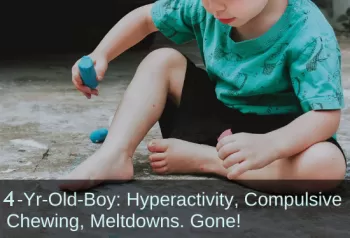Primitive Reflex Integration Case Studies
4-Year-Old Boy: Hyperactivity, Compulsive Chewing, Meltdowns. Gone!
Autistic preschooler benefits from rhythmic movements and reflex integration
This 4-year-old with autism experienced an array of learning, motor, behavioral, and emotional challenges; as well as compulsive chewing of non-food items. With the rhythmic and reflex integration movements from the Brain and Sensory Foundations course, he made tremendous progress in all areas.
Submitted by Kendel Knudson OTD, OTR/L

| Before | After |
|---|---|
| Difficulties sitting still | Much less hyperactive |
| Chewed on things (blinds, curtains, toys) | No longer chews on non-food items |
| Unable to follow directions | No longer requires a visual schedule |
| Difficulties transitioning | Now able to transition easily between activities |
| Scribbled aimlessly | Coloring is more organized |
| Frequent meltdowns | Fewer meltdowns |
| Unable to maintain a tripod grasp | Can maintain a tripod grasp for ~5 minutes |
| Difficulty imitating lines, shapes, and block patterns | Can imitate horizontal/vertical line, circle and cross, and write name |
| Poor core strength | Improvements in core strength and ability to lift head |
This case study is about a 4 year old boy named “Jake”. Jake came to me with a diagnosis of sensory processing disorder, Autism, auditory processing disorder, and fine motor delay.
When Jake first came to me he was extremely hyperactive. He had difficulties sitting still, attending to directions, and was very impulsive. He had difficulties with transitioning and had frequent meltdowns. Mom felt that she would talk and say things to him but he had difficulty understanding or would not listen. Jake liked to chew on things (blinds, curtains, toys). So much so that he could not be in a room by himself.
Upon assessment Jake also showed difficulties with motor planning (jumping jacks) and fine motor control. He would just scribble aimlessly on paper, was unable to maintain a tripod grasp, and had difficulty imitating lines, shapes, and block patterns. Jake had poor core strength and was unable to demonstrate prone extension or supine flexion.
Jake showed presence of the following reflexes: Fear Paralysis [Reflex], Moro [Reflex], TLR [Tonic Labyrinthine Reflex], ATNR [Asymmetrical Tonic Neck Reflex], STNR [Symmetrical Tonic Neck Reflex], Both hand reflexes, Spinal Galant [Reflex].
We started with Rhythmic movements [from the Brain and Sensory Foundations course]. Jake enjoyed the movements and participated well in therapy. The movements were recommended for home and Jake would frequently ask for them when upset or before bedtime.
We next focused on TLR integration [from the Brain and Sensory Foundations course] with a lot of developmental play, crawling, and activities that worked on supine flexion or prone extension. During sessions we also used a visual schedule to help Jake stay on task. Through the weeks, we moved onto Moro and fear [paralysis reflex] and then through the rest of the reflexes. Mom was very proactive and was able to do the movements at home.
When working with Jake I began with the rhythmic movements because I felt that these would be great foundation for him. I noticed how calming they were during treatment session and felt they would be a good tool at home as well. Although Moro and Fear were present, I started with TLR because I felt it was limiting his progress the most.
After about 6 sessions I stated to observed improvements in Jake’s core strength and ability to lift his head. It was around this time that I started to go back and really work on the Moro and fear reflexes which quickly integrated at this time. Fine motor was a big concern as well and so incorporated a lot of hand sensory play with putty, beans, and sand prior to writing activities. He would also to the palmar babkin and grasp isometrics [from the Brain and Sensory Foundations course] before writing activities as well. With these it took ~ 4 sessions before I was able to see a difference. He demonstrated less mouthing of objects and was able to maintain a tripod grasp for longer. His pencil/crayon pressure became more appropriate and he enjoyed sitting and coloring much more than he used to.
Jake is doing very well. He is much less hyper active at home and during therapy. We no longer use a visual schedule as he is able to follow directions and transition easily between activities. Mom has noticed a difference in his ability to transition at home and reports less meltdowns and improved auditory processing. Jake very rarely chews on non-food objects and does a much better job communicating his needs and asking for more appropriate sensory stimulation.
Jake is now able to maintain a tripod grasp for ~ 5 minutes during a coloring or writing activity. His coloring has gone from sporadic to more organized and focused on a coloring page. He is able to imitate horizontal/vertical line, circle and cross. He can write his name and is now working on the other letters of the alphabet. As mentioned earlier, Jake has a much better understanding of his own needs and frequently asks for the rhythmic movements throughout his day. Overall, Jake has made great progress and I am excited to see where he continues to go!
[Edited for length and clarity, emphasis added]
*Disclaimer: The activities in the Brain and Sensory Foundations curriculum make use of the natural processes of neuroplasticity and development that are innately wired in the design of human beings to promote maturity and function. These activities appear to calm, organize, and mature the neuro-sensory-motor systems just as we see in the healthy development of human infants. Individual results may vary, and we do not claim to offer a diagnosis or cure for any specific condition or disorder. The Brain and Sensory Foundations activities appear to improve overall functioning resulting in measurable improvements for a range of conditions as demonstrated in over 1800 case studies from participants.

